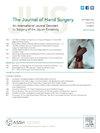The Impact of Venous Reconstruction on Finger Replantation Success Rates Based on Level of Injury
IF 2.1
2区 医学
Q2 ORTHOPEDICS
引用次数: 0
Abstract
Purpose
The requirement for anatomic venous reconstruction in digit replantation is an ongoing area of research. In this study, we evaluated our institutional experience to study whether replantation success is affected by the presence or absence of vein repair, stratified by the level of injury.
Methods
A retrospective review was performed at an urban, level-1 trauma center of all single-digit replantations performed in adults from 2012 to 2021. Patient demographics, injury mechanism, level of injury, whether a vein was repaired, and replant survival were recorded.
Results
Sixty-seven single replanted digits were included. Patients were, on average, 38 years old, and 94% were men. The most common mechanism of injury was a sharp laceration (81%). The overall survival rates for all replantations were 68.7% (46/67) and 60% (12/20) for distal finger replantation. Patients with digital replantations at Tamai zone III or more proximal exhibited a 1.8 times increase in survival rates when one vein was repaired versus zero veins (84.4% vs 46.7%). Patients with digital replantations at Tamai zones I and II exhibited similar survival rates.
Conclusions
Replantations at or proximal to the middle phalanx should be repaired with at least one artery and vein to maximize the chance for success. However, for distal finger replantations, artery-only replantation is a viable option when vein anastomosis is not achievable.
Typo of study/level of evidence
Therapeutic IV.
静脉重建对不同损伤程度手指再植成功率的影响。
目的:解剖静脉重建在指再植术中的需求是一个不断发展的研究领域。在这项研究中,我们评估了我们的机构经验,以研究静脉修复是否会影响再植的成功,并按损伤程度分层。方法:回顾性分析2012年至2021年在城市一级创伤中心进行的所有成人个趾再植手术。记录患者的人口统计、损伤机制、损伤程度、静脉是否修复以及再植存活率。结果:单指再植67例。患者的平均年龄为38岁,其中94%为男性。最常见的损伤机制是尖锐撕裂伤(81%)。所有再植术的总生存率为68.7%(46/67),远端指再植术的总生存率为60%(12/20)。在Tamai III区或更近端进行指端再植的患者,当修复一条静脉比零静脉时,生存率增加1.8倍(84.4%比46.7%)。在Tamai I区和II区进行数字再植的患者表现出相似的存活率。结论:中指骨或近端再植应至少有一根动脉和静脉修复,以最大限度地提高成功的机会。然而,对于远端手指再植,当静脉吻合术无法实现时,动脉再植是一种可行的选择。研究/证据水平错别字:治疗性IV。
本文章由计算机程序翻译,如有差异,请以英文原文为准。
求助全文
约1分钟内获得全文
求助全文
来源期刊
CiteScore
3.20
自引率
10.50%
发文量
402
审稿时长
12 weeks
期刊介绍:
The Journal of Hand Surgery publishes original, peer-reviewed articles related to the pathophysiology, diagnosis, and treatment of diseases and conditions of the upper extremity; these include both clinical and basic science studies, along with case reports. Special features include Review Articles (including Current Concepts and The Hand Surgery Landscape), Reviews of Books and Media, and Letters to the Editor.

 求助内容:
求助内容: 应助结果提醒方式:
应助结果提醒方式:


